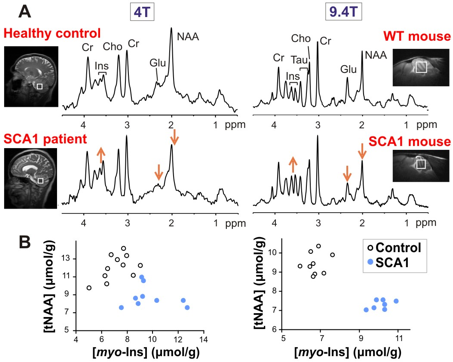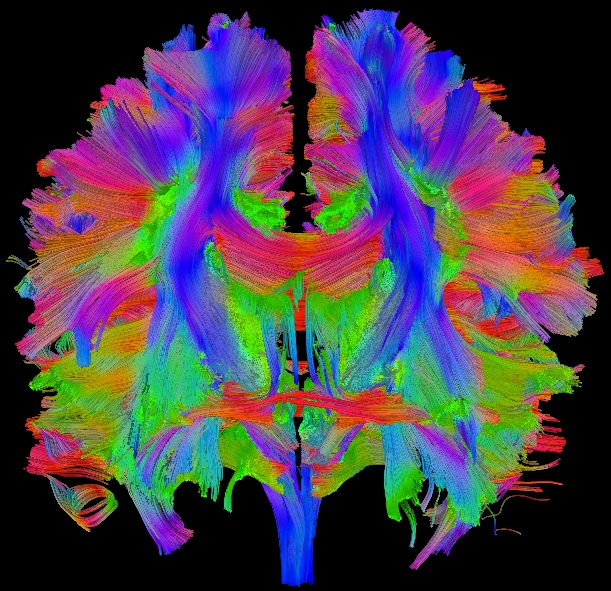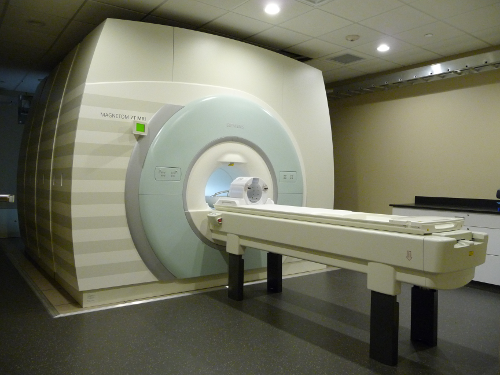
CMRR
Center for Magnetic Resonance Research, Department of Radiology
Research Highlights - Ataxia
You are here
Ataxia is neurological condition, which affects the cerebellum, an area of the brain responsible for coordination of movement, speech and the senses. CMRR’s ataxia research efforts began in 2005 through a collaboration between magnetic resonance spectroscopy researcher Gulin Oz, Ph.D. and neurologist Christopher Gomez, M.D., Ph.D., now at the University of Chicago.
The goal of ataxia research at CMRR is to identify biological markers with the aid of magnetic resonance spectroscopy that reflect the progressive neuronal dysfunction and loss in the cerebellum, and that can be utilized to monitor drug effects in clinical trials. CMRR pioneered advanced spectroscopy techniques necessary to view pertinent biochemical changes in the brain. CMRR has distributed these advanced techniques across the globe for use in basic and clinical research and clinical trials focused on ataxia and other brain diseases. Click here for licensing information. Recently, researchers at CMRR have also started to investigate the structural (“wiring”) and functional (“activation”) connectivity alterations in the brain and spine of patients with ataxia. This research benefits from novel and fast imaging techniques (See details here), pioneered as key components of the Human Connectome Project (HCP), and advanced computational tools also developed at CMRR. Ultimately, complementary MR spectroscopy and imaging techniques might provide a better, global picture of the pathological mechanisms responsible for neuronal alterations in ataxia.

Parallel neurochemical alterations in patients (left) and transgenic mouse models of neurodegeneration (right). (A) Proton MR spectra obtained from the cerebellum of a patient with spinocerebellar ataxia type 1 (SCA1) and a mouse with the same genetic mutation are shown in comparison to healthy controls. (B) Metabolite concentrations obtained from individual subjects distinguish the SCA1 and control groups with no overlap (left: human data, right: mouse data).

An example of tractography representing the brain "wiring", and generated from diffusion MRI data.
At CMRR, a team of highly specialized imaging researchers focus daily on this disease
These researchers collaborate closely with other University of Minnesota researchers in the Departments of Neurology, Neuroscience, Laboratory Medicine and Pathology, Biostatistics, Pharmacology and Mechanical Engineering to develop novel approaches to detecting and treating this disease.
This work is funded by
- National Institute of Neurological Disorders and Stroke
- Bob Allison Ataxia Research Center
- UMN Institute for Translational Neuroscience
- National Ataxia Foundation
- Friedreich’s Ataxia Research Alliance
Related Links
- Clinical Patients UMN Ataxia Center
- Learn about ataxia National Ataxia Foundation
- Ataxia Research at the U Bob Allison Ataxia Research Center
- Fredreich's ataxia study with Kyle Bryant at CMRR July 23, 2013
Read more about CMRR Ataxia research in the media
- The Line Up Fall 2008
Catching a chemical before it does damage
- Minnesota Medical Foundation Medical Bulletin, Winter 2009
A powerful force: The Center for Magnetic Resonance Research, soon to house the world's strongest magnet, is pushing the technology's limits
- The Line Up Spring 2009
Researchers hone in on markers for AOA2
- Academic Health Center, Health Talk blog August 22, 2012
U of M researcher looks to stay one step ahead of debilitating brain disease

The CMRR's powerful 7.0T MR instrument is used to study ataxias.